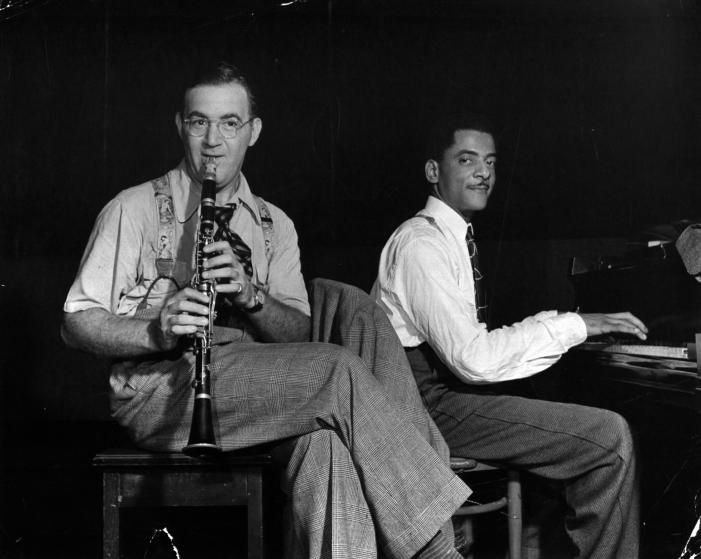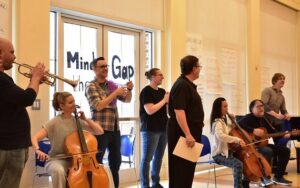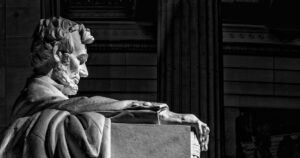An old legend has it that in the 1920s, Texas jazz trombonist Jack Teagarden had said to legendary trumpeter Louis Armstrong, “You a spade, I’m an ofay… Let’s blow!” While using somewhat off-color language by today’s standards, what Teagarden was essentially saying was, “you’re black, I’m white. So what if we’re different—let’s jam!” And that was the attitude of many jazz musicians of the time, like Bix Beiderbecke and Benny Carter, and of later musicians like Benny Goodman, Miles Davis, and Dave Brubeck. It really was moot what the other musicians’ backgrounds were, so long as they could play.
Now, imagine an alternate reality where Teagarden had simply said to Armstrong, “You’re black, I’m white. I don’t care if we both play jazz, we can’t do it together.” How differently would America’s original art form have turned out?
But for the last several years, especially since 2016, fears ordinary Americans hold about people from opposing political parties, different ethnicities, and anyone else grouped as “the other” have risen to the surface and boiled over. America has survived deep, broad polarization before– think the Civil War, or the civil rights and antiwar movements of the 1960s. But the rise of social media, the 24-hour news cycle, and the persistently familiar territory of camping out amongst one’s own tribe, have made it that much more difficult to have civil discussions regarding hot-button issues, and to maintain healthy relationships across those divides.
It’s strange to think about how jazz music can be a possible resource for bringing folks together, especially during tough times. But it’s possible, if you know where to look.
Take the story of Leon “Bix” Beiderbecke, for example. He was one of the best horn players of the 1920s besides Louis Armstrong, with a lyrical, emotional tone to his cornet that could just flow right through you. During the 1920s, he was the white musician to emulate—and he and Armstrong were friends. In a period when segregation was the order of the day, and whites and black were not expected to mingle even in private, jazz musicians disregarded this custom in favor of making great art. “While the rest of the country was keeping blacks and whites apart in the early 20th century, jazz musicians – including Davenport’s own Bix Beiderbecke – were living in harmony.”
Musician and Beiderbecke historian Randy Sandke, in his recent book Where the Dark and the Light Folks Meet: Race and the Mythology, Politics, and Business of Jazz,” examined just how Beiderbecke’s social views were as important as his musical achievements: “He was really ahead of his time not only musically but, I think, in terms of racial interaction. Black musicians appreciated the fact that he accepted them and really appreciated their music. He was not a judgmental person.” In due time, Beiderbecke would influence both musicians both black—including Louis Armstrong, Doc Cheatham, Roy Eldridge, and Rex Stewart—and white, including Jimmy McPartland, Red Nichols, Hoagy Carmichael, Bobby Hackett, and Benny Goodman.
In September 1921, at the age of 18, Beiderbecke had been sent to Lake Forest Academy, a boarding school in Illinois. His parents did this to “straighten him out” and discourage his interest in jazz. But the institution was a just short train ride from Chicago, which was then becoming the jazz capital of the world. It was there that Bix would stay out past curfew, sitting in with local bands and even watching a young Louis Armstrong perform with King Oliver’s Creole Jazz Band. Beiderbecke was one of a handful of young white musicians who were so moved by jazz that they ventured into Chicago to hear their idols play this strange new music. Most notably, a bunch of boys known as the “Austin High Gang,” after the Chicago suburban high school they hailed from, were quick to acknowledge the influences black jazz musicians had on them.
In his large tome, Lost Chords: White Musicians and Their Contributions to Jazz, the late historian and musician Richard Sudhalter explains how race simply mattered less to these passionate young white musicians: “Suffice here to say that hot music was their mania…They made no distinctions between white or black, authentic or ersatz: be it the Friars Society Orchestra at the Friars’ Inn, King Oliver’s Creole Jazz Band at the Lincoln Gardens, Isham Jones and Louis Panico at the College Inn, or Doc Cooke’s big orchestra at the Dreamland Ballroom, they grabbed it where and however they could.” These men quickly looked to black New Orleans musicians, such as clarinetist Johnny Dodds, cornetist Freddie Keppard, or even Armstrong, for guidance and instruction, and it didn’t matter to them that their idols were black. They just loved what they were hearing, and knew they wanted to play that style of music. Even a young Benny Goodman, while studying clarinet in Chicago under Franz Schoepp, would go off into a room with the black clarinetist Buster Bailey and trade licks. Famous tenor saxophonist Lester Young said he carried around C-melody saxophonist Frankie Trumbauer’s records with him, and admired how “Tram” told a story when he played. (Trumbauer would become Beiderbecke’s partner-in-crime for some of those most influential white jazz recordings of the 1920s.)
And the trend towards integration in jazz didn’t stop with the 1920s. In 1935, Swing King Benny Goodman debuted his famous trio with the African-American pianist Teddy Wilson, setting the stage for more public appearances between black and white musicians. Initially, Goodman was reluctant to introduce Wilson to a major gig at a hotel, but when he did, the move revolutionized jazz, and Goodman later added more African-Americans to his band, including vibraphonist Lionel Hampton, guitarist Charlie Christian, and many more over the decades. Trumpeter Clark Terry once told Sandke: “…people like to pit, black against white, and I think it’s so wrong because we’ve all been inspired by one person or the other…a note doesn’t give a damn who plays it whether he’s black or white as long as he plays it good.”
Sadly, there have been too many instances in jazz history where race was, in fact, a factor. Cornetist Nick LaRocca of the Original Dixieland Jazz Band, was notorious for claiming that early jazz, notably Dixieland, was “strictly a white man’s music,” and in 1937, the height of the Swing Era, LaRocca credited whites with originating the popular style, rather than the Harlem bandleaders Fletcher Henderson, Chick Webb, and Duke Ellington. 20 years later, LaRocca continued to push the notion that whites were the true pioneers of jazz, and a colleague of his, pianist Johnny Lala, also argued that “Negroes may have invented the music, but whites improved on it.” Neither of these viewpoints sound like anything Beiderbecke, Trumbauer, or Goodman would have adopted.
Still, the fact that these tensions existed in the jazz world made what racial integration jazz did achieve more remarkable, and interesting. Just imagine how the music would have turned outif Benny Goodman never brought Teddy Wilson into his trio, or if Miles Davis refused to work with Gil Evans on three landmark albums, or if Frank Sinatra dismissed the notion of playing live with Count Basie’s band and Quincy Jones.
In a recent New York Times Op-Ed piece, Actress Cate Blanchett explains why she chose to portray Phyllis Schlafly—a historical figure with whom she strongly disagrees in reality—in the recent Hulu series Mrs. America: “I was drawn to investigate, illuminate, make sense of and hopefully understand the apparent gap between us.” Doesn’t this drive of curiosity exist at the very heart of art and creativity? If so, nowhere can it be more commonplace than in jazz, where musicians from all different walks of life get together. They may vote for different candidates and worship different gods, but the moment they start to play, all of that other stuff goes right out the window.
And not only does great jazz come out of bridging conversational divides between black and white. The art of conversation between different minds is as essential to jazz as to pluralistic democratic societies. If a trumpeter doesn’t pay careful attention to what the alto saxophonist or pianist are doing, they may very well lose their place in the song (and not in a good way) and miss that chance to come up with something brilliant and spontaneous that helps move the conversation along and enrich the performance. They will have just witnessed the damage of “not listening.” Jazz musicians don’t have to agree with each other’s notes, but they should inspire each other, just as two people discussing a hot topic in politics should acknowledge their differences while keeping an open ear for other points of view to take the narrative in a more dynamic direction.
The same holds true in America today. People aren’t hearing each other, and even when they do hear different perspectives, they’re not always actually listening. As a result, the conversation remains stuck in the cacophony of shouting and name-calling, like a jazz standard that repeats itself over and over through several choruses, inspiring no emotional reaction from either the musicians or the audience. The inevitable result: a lackluster performance.
In 1959, Miles Davis walked into Columbia Studios in Manhattan with John Coltrane, Bill Evans, Julian “Cannonball” Adderley, Paul Chambers, and Jimmy Cobb to record their landmark album, Kind of Blue. Aside from being a racially-mixed group (Evans was the only white player,) the session was innovative for a few other reasons.
For one thing, it was the LP that launched “modal jazz”—a new subgenre built around scales for soloing, as opposed to the usual chord progressions that had reigned since the 20s. In addition, it illustrated the conversational demands of collective improvisation. Davis called for no rehearsals, and showed up that day with basic sketches he’d created only hours before. The musicians started playing with minimal guidance, and improvised based on what they’d brought with them. These are just a few essential elements that made this legendary recording the historic art that it has become. Evans’s notes in the original album’s liner summed up the atmosphere: “Group improvisation is a further challenge. Aside from the weighty, technical problem of collective, coherent thinking, there is the very human, even social need for sympathy for all members to bend for the common result. This most difficult problem…is beautifully met and solved on this recording.”
Evans is suggesting that putting aside our differences opens room for understanding, and helps us reach conclusions we couldn’t have found on our own. One need look no further than brilliance of the album’s opening track, “So What,” a 32-bar modal composition that set the tone for what ended up being one of the most influential and well-done albums of the 20th century. One might even go so far as to say its melody—16 bars of the D and Eb Dorian scales arranged to sound like someone saying “So What?”— is shorthand for “who cares about all that other stuff; let’s just play and have fun.”
Does that mean Kind of Blue is the key to solving our political discourse? Not quite. But in that one quote, Bill Evans characterized the beauty that is the very essence of jazz, and American politics in 2020 would do well to take a cue from the “playbook” that jazz musicians explored so well almost 100 years ago.
We’ve already seen how bad things can get when folks just shout, point fingers at each other, and don’t get a word in edgewise. And right now, in the midst of a global crisis, America would be wise to heed the lessons of some of its greatest artistic forebears.
Instead of “I’m liberal, you’re conservative. Let’s talk”, our discourse has devolved into “I’m liberal, and you’re the enemy,” or “as a conservative, I’m a patriot and you’re not!” How are we going to get anywhere with that attitude?
Jazz musicians are often described as “storytellers,” and when they get together to jam, they’re essentially talking to each other. So in this great American symphony we live every day, let’s all take a few breaths, acknowledge our differences, and talk. And don’t forget to listen!
Jack Teagarden and Louis Armstrong – Basin Street Blues




